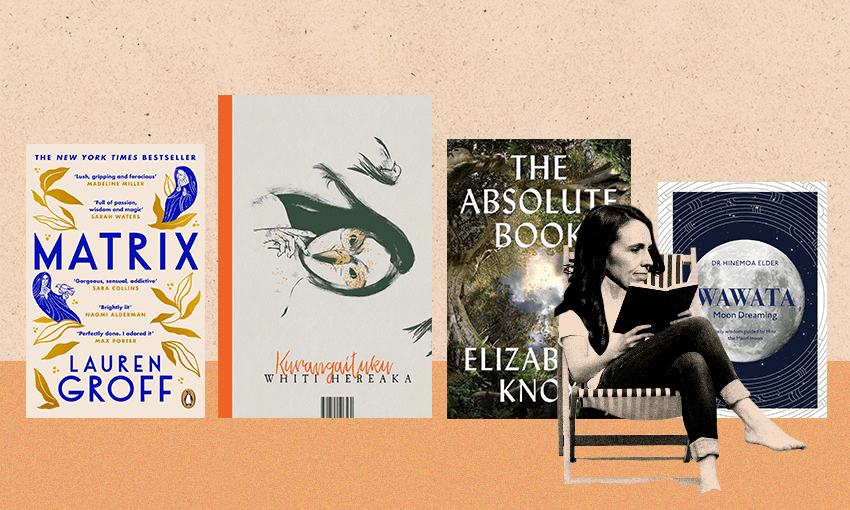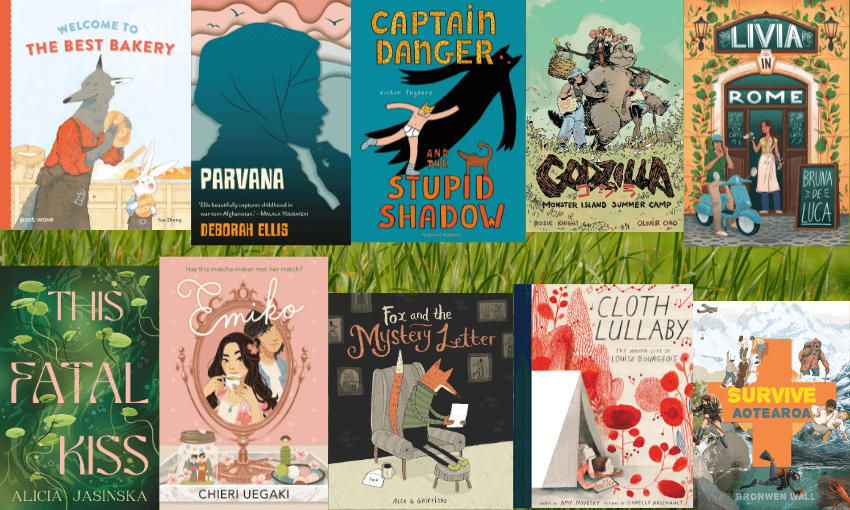Books editor Claire Mabey offers some bibliotherapy for when Jacinda Ardern can flick on her out of office and enjoy a cuppa tea and a lie down.
If anyone deserves to lounge in a deckchair by the pool with a tangy cocktail and a stack of books, it’s soon-to-be-former prime minister Jacinda Ardern. After what has been a monumentally exhausting six years I am hereby calling upon the current prime minister to insist that the soon-to-be-former prime minister undertake a period of time spent doing sweet FA, and reading for pleasure. The benefits of sustained silent reading are endless: sitting down with a book and limited distraction literally heals a burnt-out brain. (Frankly, there ought to be a National Day of Sustained Silent Reading, just a morsel there for any future prime ministers wanting to win over the several million+ readers among us.) The following list is a dose of bibliotherapy designed on the principles of “if you liked that then you’ll love this”, and with escape, rest and tank-filling as top priorities.
Lolly Willowes by Sylvia Townsend Warner
Look, I know I harp on about this novel (originally published in 1926) but I’d prescribe to anyone in need of rest and affirmation that our lives can be our own. In short, the plot: a tired woman who has worked her ass off during a nightmarish global situation (World War One) makes the call to leave the city and its various trappings and head for a new life in a small village where she can do whatever the hell she likes, without the judgement of others. On the way she discovers that she is a witch and that women everywhere are powerful, wise, and full of potential that is too-often stifled by arrogant pricks. Just a hunch that this short and delightful novel about the joys of change, transformation and freedom might be relatable. The author, Sylvia Townsend Warner, was an astoundingly inventive writer and a brave person who gave her all to her craft, her family and her beliefs.
Wawata by Hinemoa Elder
Dr Elder’s book is a practical guide to the Maramataka and the questions that Hina the Māori moon can help us to ask of ourselves. This book offers a very 2023 energy: an alternative to the Western, time-based constraints that often force us against the ebb and flow of our energy cycles. Dr Elder weaves her own experiences and insights throughout the book which are funny and moving. A real balm for anyone searching for a rethink on how we move through life on this planet of ours. The artist and writer Jessica Hinerangi Thompson-Carr wrote about Wawata for us, here.
Small Bodies of Water by Nina Mingya Powles
Aotearoa writer Nina Mingya Powles’ collection of essays is exquisite. They are slow, detailed considerations of swimming, nature, food, family, language, time, home, travel and the spaces between us. Powles tips the reader into a realm of quiet wonderment and beauty and helps us reconnect with the parts of life that can deliver the feeling of being alive. Read our ecstatic review here.
See also: Things I Learned at Art School by Megan Dunn, a smart, hilarious, moving collection of essays from one of the best essayists and art critics in the country (read an extract here).
Matrix by Lauren Groff
“What women can do when given a task! Their abilities seem limitless.”
This novel about a 12th Century abbess and her community is the book that you didn’t know needed. Groff is a stone-cold genius: the way she brings to life the historical-ish figure and poet Marie de France will whisk you as far away from present-day politics and otherwise as it’s possible to get. Aside from the fact that the writing is transportive – “Marie thought of her aunt Euphémie, able to turn somersaults off the back of a horse, her aunt Honorine, of the twin white peregrines, her aunt Ursule with her golden boots and furious beauty, her strong laughing vibrant mother, all merely girls then, seizing what adventure and godly grace they could take through the crusade” – the book is about women in leadership: the joy of community, the bullshit that you have to deal with, the sacrifices you have to make, the vision you need to possess.
See also: Sylvia Townsend Warner’s masterpiece, The Corner That Held Them, which traverses 400 years of life in a Medieval monastery, which makes for a meditative slow read after a time of great flurry.
Rooftoppers by Katherine Rundell
I recommend reading middle grade fiction to literally everyone but most particularly to adults who need to reconnect with their inner reserves of curiosity, imagination and sense of adventure. Children’s fiction is at once supremely relaxing to read but also energising in that you’re re-introduced to the importance of a child’s point of view. And Rundell is a master of middle grade. In Rooftoppers there’s a foundling child, an eccentric and loving caregiver, heroic orphans who live on the rooftops of Paris, cellos, danger, motherly love, discovery. It would make a wonderful book to read aloud with a nearly five-year-old about to embark on the adventure of education.
See also: Rundell’s The Wolf Wilder, and her adult book, a most spectacular, lively biography of the poet John Donne, called Super-Infinite.
The Absolute Book by Elizabeth Knox
In 2020 Jacinda Ardern recommended Knox’s Mortal Fire, saying “I love books that suspend reality, but that also remind you how incredible the human imagination can be. A story you’ll barely be able to describe after the fact, but that will have you enthralled.”
Well, Elizabeth Knox’s latest book awaits. It is Knox’s most ambitious novel to date and is a sublime adventure in and out of worlds, through mythologies hidden in plain sight, and a walloping interrogation of politics of a sort, too. There is a stunningly beautiful future vision for our planet, a character called Shift who represents narrative itself, and a pithy female lead in Taryn Cornick of the Northovers. You can read our review here.
See also: The Dawnhounds, the debut fantasy novel by Kāi Tahu writer Sascha Stronach – simply spectacular world-building (reviewed here by Tamsyn Muir).
Kurangaituku by Whiti Hereaka
Also in 2020, Ardern recommended Keri Hulme’s the bone people, saying “When I moved to New York, this book came with me. It reminded me of home. It would have travelled the world with me if it wasn’t stolen by my roommate.”
Hereaka’s Kurangaituku is a very different book to the bone people but it is similarly innovative in form, dazzling in style and potent in its evocation of place. Hereaka channels a powerful voice: the story makes you feel like you have entered another time and space to witness the reclamation of a narrative long mis-related (thanks to colonisation and the patriarchy). It’s also hugely fun to discover Hereaka’s genius disruption of Western methods of linear storytelling. This book will help re-fill that tank. Read our review here.
See also: Tauhou by Kōtuku Titihuia Nuttall. Again a very different kind of book but equally innovative and truly an exquisite reading experience.
Lockwood & Co series by Jonathan Stroud
In this book recs list, Ardern offered Tomorrow When the War Began by John Marsden. I’m delighted to see this formative (for many of us elder millennials) YA series about teenagers having to self-manage life when the world around them goes to shit. So if you like that then you’ll love Lockwood & Co, about a ghost-hunting agency run by teenagers and narrated by Lucy, who is the coolest. These books are proper scary, effortlessly entertaining and once you’ve finished reading them you can binge the Netflix adaptation which is about to begin.
See also: Flight of the Fantail by Steph Matuku, a gripping stand-alone that is surely also made for excellent TV.
The Raven’s Song by Bren MacDibble and Zana Fraillon
That’s right, more middle grade: because this genre can offer adults a tremendous amount of tank-filling, perspective shifting and armchair adventure. The Raven’s Song is an extraordinary achievement. The authors (MacDibble from Aotearoa, Fraillon from Australia) have crafted charming, heart-achingly wonderful child characters through which we access a vision of our world dramatically altered due to human destruction. Laced with the motifs and atmosphere of folktales and with arresting and intricate worldbuilding it keeps the reader captivated, and clinging on to hope, all the way through. Another brilliant book to share with small readers in the family: relevant, important and rousing.
The Collected Letters of Katherine Mansfield edited by Vincent O’Sullivan with Margaret Scott
Endurance by Alfred Lansing has been cited as one of Ardern’s favourite ever books. I can see why: there is nothing more compelling than vicariously living through gruelling human endeavour and acknowledging the feelings of awe and respect that that kind of storytelling can evoke. Also among Ardern’s reading recs is the novel in diary form, Go Ask Alice. It’s always riveting, illicit somehow, to read a person’s personal scribblings so readily. So, given that 2023 marks 100 years since Katherine Mansfield died (too young at age 34 after enduring long periods of illness) it’s timely to suggest that a soon-to-be-former prime minister delve into Mansfield’s letters. They are laced with endurance and struggle; peppered with vivacity and wit and life; they are funny and cutting and romantic. It’s also apt to consider how Mansfield continues to be an influencer: she was one of the foremost writers of the Modernist movement, compelled to do things differently, which changed literature forever.
So here’s to you, Jacinda Ardern: thank you for doing things differently. And enjoy your well-deserved rest and reading.



